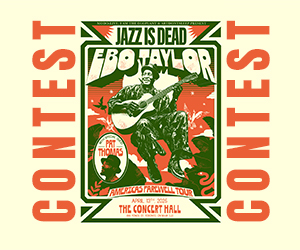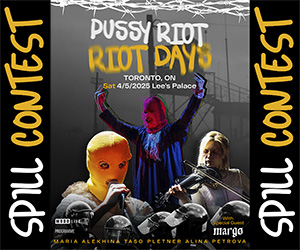FINDING OUR NORTH STAR
A CONVERSATION WITH FAME ON FIRE
It is impossible to avoid thinking of Fame on Fire when one hears the word “inspirational.” This band initially gained traction as a cover band on YouTube, and few would have predicted that they would evolve into a significant and distinctive presence in the rock industry following the release of their debut album, Levels. While Fame on Fire would make themselves known as a multi-genre rock band with an infectiously sharp edge, such an audacious blend of pop, nu-metal, and rock elements would continue to unfold on their sophomore release, Welcome To The Chaos. A stunning instrumental and lyrical attraction that would punt its way forward from what listeners experienced on Levels, Fame on Fire would rejuvenate and reinvent their sound, grafting in rich, modern, and diverse elements that would far surpass their previous efforts. While one might argue that Welcome To The Chaos is not a complex release on the surface, a careful listen reveals that it’s not about flashy elements but rather successful risk-taking. But it did demonstrate how the band had evolved from their modest YouTube beginnings to something more sonically in-depth and captivating by pushing themselves. Fans eagerly anticipated what the band had in store after the innovative emergence of Welcome To The Chaos, which skillfully blended a profound sense of gratifying nostalgia and freshness. Coming into their new release, The Death Card would carve out a band from the marbles of growing pains of a successful debut release and sophomore release, bringing about a work of art that details a different kind of dissonant spice and introspective energy that stemmed from over two years of evolution.
“Thank you for the kind words; honestly, it means a lot. For us, this album represents everything we have been working towards,” replies vocalist Bryan Kuznitz
. It’s a transition to the band that we have always wanted to become. We are making music that we have always wanted to make. We finally made a cohesive effort from front to back. It’s not like we wrote songs, put them together, and made an album. We made this album with intent. The goal of the record was to create a cohesive whole experience by maintaining a consistent tone and feel throughout the songs and revolving around the strong themes of tarot. So, it was all thought out beforehand.”
Guitarist Blake Saul continues, “I think everything down to its core, The Death Card, represents a lot of double meanings for us. There’s a lot more meaning than what’s on the surface. But if you look at things on the nose, The Death Card means a part of you needs to die for something new to be born. I think we have done a decent job over the past couple of years of discovering who we are and trying to figure out our identity. I feel like we are now in a moment where we have actually set out to be what we want to be. This isn’t to say that our past releases are not us or in a different direction; we’re still us. We just feel as though we have reached our desired destination in our careers and are seated at the table of where we want to be. The Death Card represents exactly that.”
While The Death Card represents a journey of dreams realized, rebirth, and a discovery of one’s true self, such profound themes of moving forward are surrounded by an even deeper malleable musicality, matching intense, well-defined moments of hard rock, piano-laden melodies, fiendish electronic energies, and nostalgic pop catharsis. But letting go of the past and embracing the future—both musically and personally—would present new difficulties and larger undertakings than what they had accomplished on earlier albums. Unlike their previous experience with their self-produced album Welcome To The Chaos, they would be collaborating with a producer this time.
“It was cool, honestly. I think Eric and us have a very similar mind when it comes to writing music,” says Kuznitz. “So, it was an easy process to be able to work with him. He understood everything from the start. He helped us explore many things that we wouldn’t normally try in the studio. So, we came out with a totally different outcome in the studio due to that.
Also, it was difficult working with someone in terms of telling you how to sing in ways you had never sung before. But it was also great because, looking back at it, he pulled everything out of me. Not just me, but all of us. From my perspective, working around the vocals and stuff like that, I am very thankful for it, but it was insane. It felt like boot camp,” he laughs. “But the result was so worth it; the juice was so worth the squeeze,” he smiles.
“I agree, the juice was definitely worth the squeeze,” Saul laughs. “Working DIY for as long as we have, on one side of the coin we are very protective, but we are also eager to become better musicians, singers, and writers. I think what was very nice was even though you got the band and the producer, it didn’t feel like that. It felt like one whole entity. As Bryan said, we all have similar minds and ways of approaching being creative. At the end of the day, whether it was dealing with the highs or the lows, it ultimately pulled out the absolute best in all of us. It’s a shame. I’m happy that the record is done, but I kind of miss being in the studio working on it. It was one of the best moments of my life. Just great hangs, great times. Even when you get to a creative block or wall, being able to look at each other and rely on each other as a team is awesome.”
Entering the harsh and intimate realm of Welcome To The Chaos, Fame on Fire would take a step forward within their lyrical vulnerability, exploring personal struggles, heartbreak, and addiction. To this point in their careers, Welcome To The Chaos had been, in many respects, their most honest and introspective release. In their latest album, The Death Card, Fame on Fire delves into a profound sense of vulnerability, illustrating the struggles they have encountered. The use of tarot cards throughout the album symbolizes themes of fate, rebirth, and the arduous journey of overcoming one’s past. The album beautifully captures the experience of a person who has been granted the opportunity to begin anew, depicting the transformative impact of their trials and tribulations.
“This was an idea that Paul had brought up to us. Paul wanted to have this interesting concept where we use tarot cards for the album’s theme. I said, ‘That sounds dope; let’s do that.’ So, when he brought this idea to us, we wanted the lyrics to make sense with this concept. Not just me, but all of us dove really deep into tarot,” reflects Kuznitz. “It’s interesting because my sister does all the tarot reading and stuff like that. So, I reached out to her to get her opinion and perspective on things, writing lyrics and going back and reading the meanings behind the cards. Also, you’re reading these cards and you’re going, ‘Okay, how can this make sense in my life?’ or ‘How can this relate to people?’ So, we dove really deep into the world of it all. We dove so deep that we would go back on some songs and ask ourselves, ‘Does the meaning match up to this card perfectly? or ‘Is this the exact card that would work best with this song?”. There are a couple of songs that got swapped out, and there are some songs that stuck very true to the theme. It made this process harder, but it also made things very direct, and it made every song very important. Before, we could write songs about anything, but these songs had to fit in the box and you had to get creative, ‘How does this relate to me?'” or ‘How does this relate to us as a band?’ So, it was cool, but it was also very hard,” he laughs.
The creation of The Death Card was an incredibly challenging and intense journey for the band, pushing them to their creative limits. However, what ultimately resulted from this intense process was an album that truly reflects the band’s growth and resilience in the face of emotional struggle.
“Working with a producer to process these emotions with this concept was one of the biggest things,” says Bryan. “Like Blake said, it really felt like he was one of us and was apart of the band, but he was also like this outside force. He was kind of like our dad,” he laughs. “Whatever he says goes, you know. It was definitely a test of knowing your limits and how far you can be pushed. When you’re doing something yourself, you never know how far you can actually push yourself. Not just from your performance perspective, but from a writing one as well.”
Bassist Paul Spirou continues, “I think honestly, based on what we are doing versus what we were doing, I think working with a producer really validated a lot of things for myself and the rest of the band as far as writing music and how things work. So, it was nice to finally know what we have been doing is the best way to do things, and we are not too far off from others that are doing the same thing. It was nice to collaborate with a producer rather than just have someone do everything for us. That’s something I took out of this and I think everyone else did too. There is a lot of feeling and emotion that we put into this record, and I hope people can resonate and take something out of that.”
Saul adds, “There are a couple of things I took from this experience. For us, a big difference between The Death Card and Welcome to the Chaos, as far as the process goes, is that we always had our north star. We always knew where we wanted to go as far as creating a good song and something that was unique to us. But this time around, we sort of had an actual compass in our hands from start to finish. We knew where we wanted to go and how to get there; tarot cards were not the bread and butter, but more so the tool, and I think we have done very well with the theme and branding of this record. We didn’t just hang up our hats on tarot cards; we used it as a tool to look at things introspectively. Having that compass from top to bottom, inside and out, we were able to work backwards, and I think the process made us look further within ourselves versus externally. It didn’t make things easy, but it definitely made things simpler and certainly more raw and authentic.”











